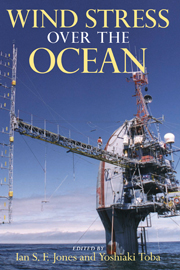Book contents
- Frontmatter
- Contents
- Preface
- Acknowledgements
- Contributors
- Frequently Used Symbols
- 1 Overview
- PART 1
- 2 Historical Drag Expressions
- 3 Atmospheric and Oceanic Boundary Layer Physics
- 4 Ocean Wave Spectra and Integral Properties
- 5 Drag Generation Mechanisms
- 6 Coupling Mechanisms
- 7 The Measurement of Surface Stress
- PART 2
- References
- Index
4 - Ocean Wave Spectra and Integral Properties
Published online by Cambridge University Press: 16 October 2009
- Frontmatter
- Contents
- Preface
- Acknowledgements
- Contributors
- Frequently Used Symbols
- 1 Overview
- PART 1
- 2 Historical Drag Expressions
- 3 Atmospheric and Oceanic Boundary Layer Physics
- 4 Ocean Wave Spectra and Integral Properties
- 5 Drag Generation Mechanisms
- 6 Coupling Mechanisms
- 7 The Measurement of Surface Stress
- PART 2
- References
- Index
Summary
Introduction
Ocean wind-waves play a dominant role in air–sea interaction processes, and, despite much progress, understanding the complex underlying physical processes involved in ocean wave dynamics continues to present a substantial scientific challenge. Two tasks confront us now: first, to establish a viable theory of wind-wave generation, and second, to describe the ocean surface quantitatively. Although the emphasis of this chapter is on wind-wave spectra, a brief description of wind-wave generation theory and the concept of local equilibrium with the wind is necessary to appreciate the uncertainty and problems facing us.
There are two existing theories on wind-wave generation; both published in 1957. The first one is by Phillips (1957), who proposed resonant interaction between the waves and the pressure field associated with the wind as the generation mechanism. Lacking a feedback mechanism, the original result was only valid for the initial stage of the wave field where the growth is linear. Phillips's theory was subsequently modified by Miles (1959a, b) to include partial feedback and resulted in an exponential growth in the principal stage. The second theory is due to Miles (1957, 1959a, b, 1962, 1967), who proposed the instability of an inviscid shear flow as the main energy transfer mechanism, which causes the waves to grow exponentially. Because this model requires the existence of a wave field at the beginning, it explains more of a wind-wave interaction process rather than the actual generation phase (see, for example, Phillips 1977).
- Type
- Chapter
- Information
- Wind Stress over the Ocean , pp. 82 - 123Publisher: Cambridge University PressPrint publication year: 2001
- 1
- Cited by



